
Standing majestically at 4,095 Meters (13,435 feet), Mount Kinabalu is the highest mountain of Malaysia. Mt. Kinabalu derives its name from the Kadazan word, Aki Nabalu, meaning ‘the revered place of the dead’. It is one of the most conquerable peaks in the world. This article will help you to reach its summit, with some info that travel agents don’t want you to know.
News (10 Dec 2016): Besides the standard Ranau trail (open on 1 Dec 2015), the second summit trail named Kota Belud Trail is open on 9 Dec 2016.
- The maximum number of climbers (daily quota) is 135 climbers per day.
- Climb Permit fee is now RM200 for foreigner; RM50 for Malaysian.
- Child under 16 must be accompanied by a dedicated Mountain Guide. Each Mountain Guide can only take up to 2 children (or up to 5 adult climbers).
- Mountain Guide who takes care of children will not guide adult climber. For example, if your group has 3 adult and a child (below 16) climbers, you must hire two mountain guides (one to take care of adult, another one for child only).
- The rate of mountain guide service is RM230.
- The rate of porter service is RM65 per day.
You may follow the Facebook of Sabah Parks for latest news and notice.
Mount Kinabalu’s specialty lies in its location at a renowned World Heritage Site – Kinabalu Park. Nature lovers will be delighted to be able to witness the many variations of flora and fauna that are to be found on the mountain at different altitudes.
1. How much does it cost?
I know you want a quick answer. The lowest climbing fee of Mt. Kinabalu is about RM1,351 (≈USD386) for International Tourist, RM972 for Malaysian (non-Sabahan) and RM444 for Sabahan (last updated: Nov 2015). The cost includes transportation, accommodation, meals, mountain guide, permit, insurance, 6% GST tax (a.k.a. VAT) and other expenses. Please download the Excel file to see the itemized budget. My calculation is based on the standard package (overnight in Laban Rata and start climbing at Timpohon Gate for single adult). If you want the full detail, you may download the 3D2N and 2D1N package info or view the document as a webpage.
- The Best Time to climb Mt. Kinabalu is between March and August, which are the dry seasons of Sabah. The peak season is Apr to Jun.
- You can climb in other months, but try to avoid Dec and Jan, which are the wettest months, due to the North-East Monsoon
- Laban Rata Rest House is the accommodation 2.72 KM before the summit of Mt. Kinabalu. Most climbers overnight here before conquering Mt. Kinabalu in next morning.
- If you are not allowed to climb Mt. Kinabalu in bad weather, there is No Refund.
How to Book a Climb Package
Booking the Accommodation at Laban Rata is the FIRST step. You can’t climb Mt. Kinabalu if you haven’t reserved any room on the mountain (Laban Rata). Camping on the mountain is not allowed, so is Day Climb.
A few important things to note:
- You must book at least 6 months in advance. The park allows only 135 climbers to climb per day, due to conservation and limited rooms, so the accommodation is always fully booked.
- Conquering Mt. Kinabalu requires only 2 days 1 night. (some can do it in one day but you have to be very fit)
- However, to maximize profit, Sutera Sanctuary Lodges (management of accommodation) usually sells you 3-day-2-night accommodation (with 1 extra night at Kinabalu Park, foothill of Mt. Kinabalu).
- 2-day-1-night accommodation package is available, but only open 30 days before the climbing date.
- Gunting Lagadan Hut, Panar Laban Hut, Waras Hut, and Lemaing Hostel are next to Laban Rata, and these accommodations are Cheaper.
- All accommodation package is inclusive of full meals (buffet style).
There are 4 ways to book the climb package:
1. Book with Travel Agent
If you can afford, just book the tour package with licensed tour agents such as Amazing Borneo. Though you will see a markup of price than I mentioned earlier, they will take care of everything, from transportation, registration, to the end of climb. This is the Best option.
2. Book with Sutera Sanctuary Lodges (SSL)
SSL is the management of accommodation in Kinabalu Park and Laban Rata. For booking, you can contact them at:
E-mail: info@suterasanctuarylodges.com.my
Tel: +60 88 308 914 / 308 915 / 308 916
Website: www.suterasanctuarylodges.com.my
Facebook: SuteraSanctuary
Address: Lot G15, Ground Floor, Wisma Sabah, 88000, Kota Kinabalu, Sabah, Malaysia. (see location map)
Business Hours: 9am-6pm (Mon-Fri), 9am-4pm (Sat), close on Sun & Public Holiday
E-mail: info@suterasanctuarylodges.com.my
Tel: +60 88 308 914 / 308 915 / 308 916
Website: www.suterasanctuarylodges.com.my
Facebook: SuteraSanctuary
Address: Lot G15, Ground Floor, Wisma Sabah, 88000, Kota Kinabalu, Sabah, Malaysia. (see location map)
Business Hours: 9am-6pm (Mon-Fri), 9am-4pm (Sat), close on Sun & Public Holiday
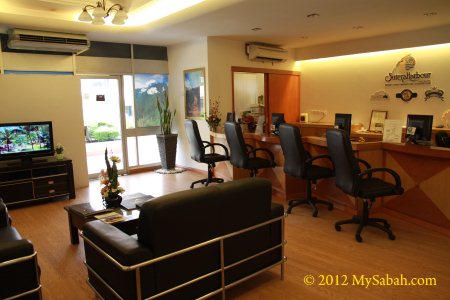
Pic: office of Sutera Sanctuary Lodges
You may drop by the office of SSL, which is located in ground floor of Wisma Sabah building in Kota Kinabalu city center and next to Wisma Merdeka, a popular shopping mall. Besides booking, the friendly staffs can answer all your questions on the spot. They can arrange full transport service for you too (the fees are quite high though). If you are lucky, you can find last minute cancellation by other tourists so you can snap up the vacancy. Anyway, don’t bet on this.
3. Sabah Parks (for Sabahans)
To get Sabahan rate, you must book the accommodation directly with Sabah Parks (Download page for Sabahan Climbers Registration Form). Though the room rate for Sabahan is the cheapest, only 25 beds are reserved for Sabahans daily. You only need to book 1-night accommodation on the mountain.
Lemaing Hostel
Sabah Parks has built a new budget accommodation named Lemaing Hostelnear Laban Rata in 2014. It has 75 bunk beds that costs RM100 (≈US$31) per person per night, cheap but higher priority is given to Malaysian climbers, though non-Malaysian can book too (They have to walk in to check the room availability on their climbing day. Advance booking not available). You may call +60 88-523531 or +60 17-8380345 for the booking. Please note that you still need to pay other mandatory fees such as climb permit and insurance.
Still No Space?
You can climb the second or third highest mountains of Sabah (and Malaysia), namely, Mt. Trus Madi (2,642M) and Mt. Tambuyukon (2,579M). Though they are about half the height of Mt. Kinabalu, the climb is much more tougher.
Itinerary of the Climb
Below is a run-down of the 3-day-2-night climbing tour in brief:
Day 1
Check-in to overnight at Kinabalu Park (see location map), which is 88 KM away from Kota Kinabalu (KK). The extra night helps your body to adapt to the height so you will be less vulnerable to Altitude Sickness (acute mountain sickness) in the climb next day. Here is a list of accommodations near Kinabalu Park.
Day 2
9am: Register and pay fees (climb permit, insurance, guide, etc.) to Sabah Parks at Kinabalu Park HQ. Collect your name tag (climb permit) and packed lunch (usually consists of sandwiches, candy bar and a fruit, with a small bottle of drinking water), then meet your guide and porter (if hired). You also can arrange return transport there to transfer you between gate and park for a fee. Be there before 10:30am or they won’t allow you to climb.
9:30am: Transfer to Timpohon Gate, the starting point of the climb.
10am: Start of Climb!
4pm: Reach Laban Rata Rest House. Usually it takes 6 to 8 hours, depend on your fitness.
– Overnight at Laban Rata (or other huts)
9:30am: Transfer to Timpohon Gate, the starting point of the climb.
10am: Start of Climb!
4pm: Reach Laban Rata Rest House. Usually it takes 6 to 8 hours, depend on your fitness.
– Overnight at Laban Rata (or other huts)
Day 3
2am: Gather and having breakfast at Laban Rata, then head to the summit.
(The park may not allow you to climb in very bad weather)
6am: Reaching the summit of Mt. Kinabalu
7am: Descending to Laban Rata
10am: Check-out and descend to Kinabalu Park
1:30pm: Back to KK
(The park may not allow you to climb in very bad weather)
6am: Reaching the summit of Mt. Kinabalu
7am: Descending to Laban Rata
10am: Check-out and descend to Kinabalu Park
1:30pm: Back to KK
Photo Walkthrough (with latest photos and info on new Ranau Trail)
Below are the photo walk-through of the 2-day climb in chronological order. The new Ranau summit trail (open on 1 Dec 2015) is 200 Meters longer than the old trail. They say the new trail is more challenging, but I didn’t feel much difference.
Or you can watch the video below:
Day 1: Climbing to Laban Rata
The standard trail starts from the Timpohon Gate (1,800m; 5,906 ft) which is about 4KM away from the Kinabalu Park Headquarters. Before reaching Laban Rata (3,273m; 10,738 ft), climbers will encounter a series of trail shelters (pondok)—Pondok Kandis, Pondok Ubah, Pondok Lowii, Layang-Layang, Pondok Villosa, and Pondok Paka. The climb from Timpohon Gate to Laban Rata normally takes 6 to 8 hours (for 6 KM).
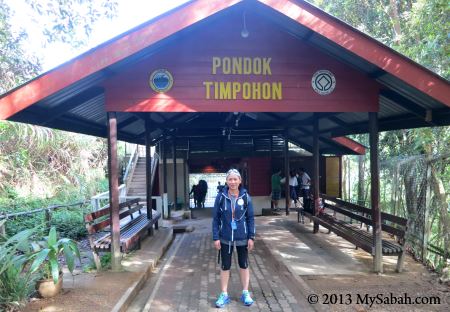
Pic: Timpohon Gate. You can buy basic supply such as snacks, drink and raincoat here.
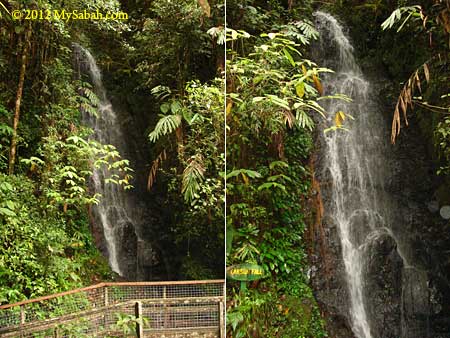
Pic: you will see the miniature Carson Waterfall very soon.
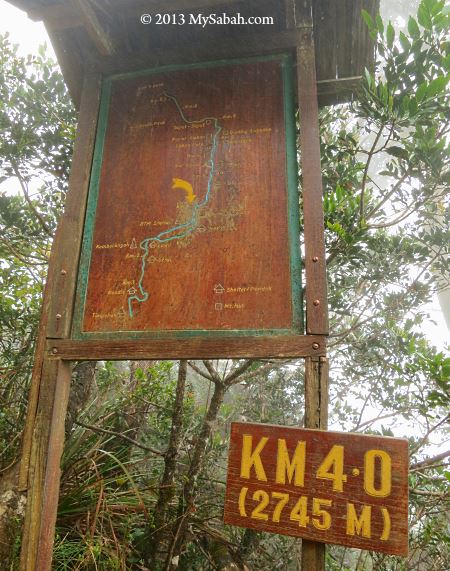
Pic: There are signages and markers every 0.5 or 1KM along the trail, to show how far you go.
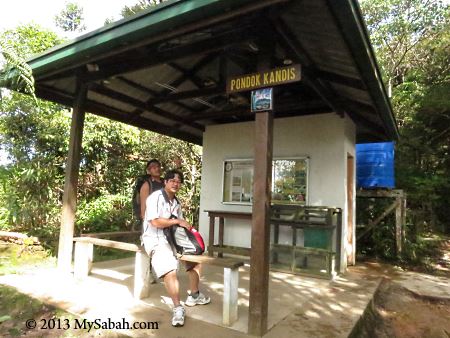
Pic: There is shelter for every 1 KM, where you can rest, refill water (untreated spring water), use the toilet and dump your trash.
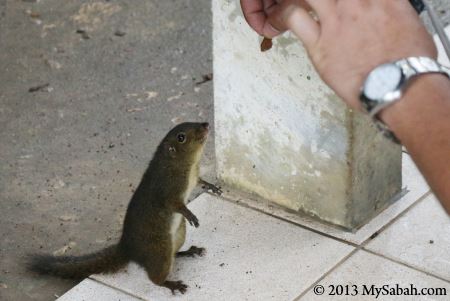
Pic: Cute pygmy squirrel would come to you wanting food.
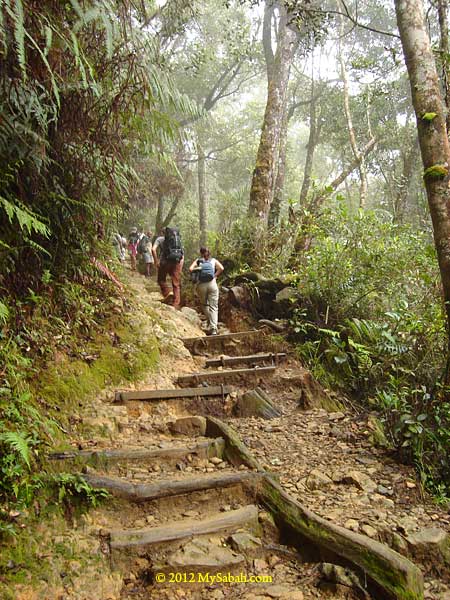
The trail is clear and in moderate steepness most of the time. You will feel like walking on endless staircase than climbing. Just go slow and enjoy the scenic cloud forest (montane forest).
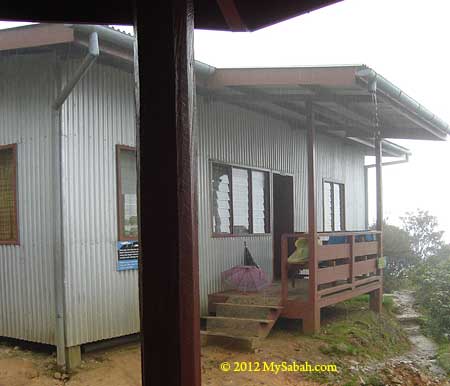
Pic: If you see this staff quarter, you are half way done.
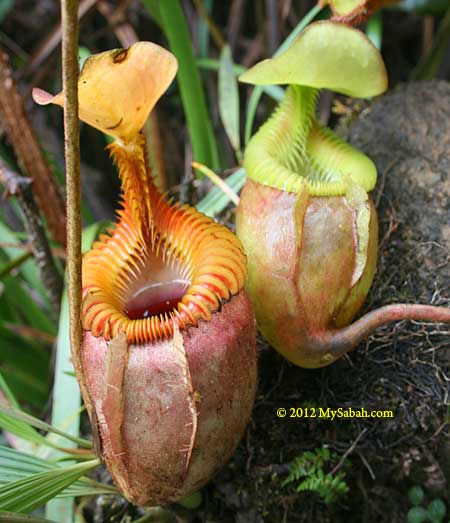
Pic: after 4 KM, pay attention to your left, you will see many big and bright-color Villosa pitcher plant in the shrubs. This species is endemic to Kinabalu Park of Sabah.
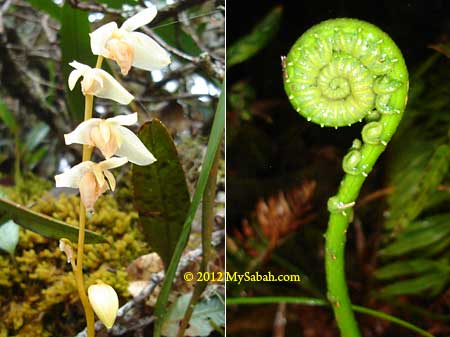
Along the trails, be sure to keep your eyes open for the plenteous interesting vegetation to check out. The unique ecology is what makes Kinabalu Park the UNESCO World Heritage Site, not just the Mt. Kinabalu. Kinabalu Park has the highest density of orchid species in the world.
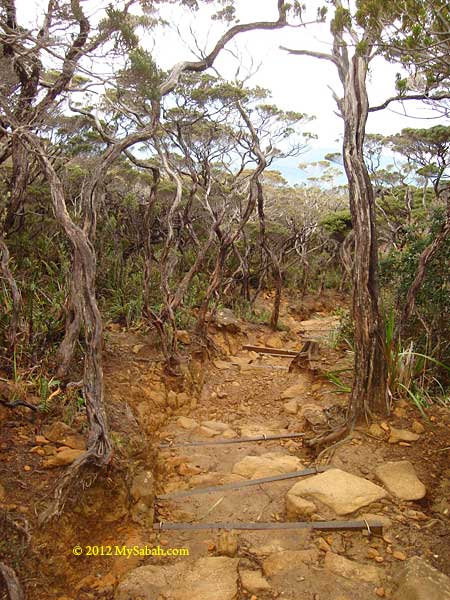
Pic: you will see the yellow path. These yellow rocks are 40-million-year-old ultrabasic or ultramafic rocks, and it is an interesting geology feature of Kinabalu Park.
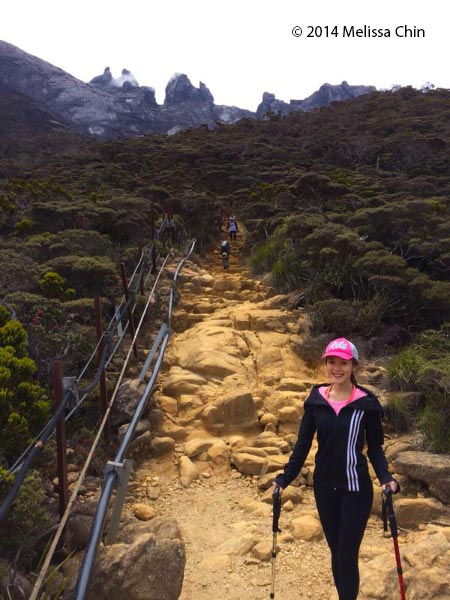
Pic: Ultramafic forest of Kinabalu Park.
Very few plant can adapt to the poor nutrients of ultrabasic soil, that’s why most vegetation in this area looks odd, as if you enter another planet.
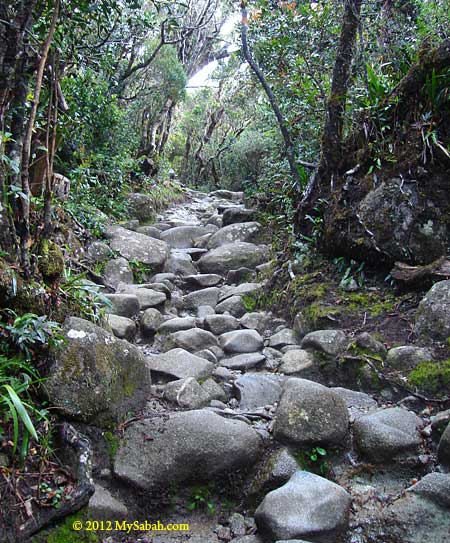
Pic: when you see the trail with big dark-grey boulders with rough edges, congratulations! You are quite near to Laban Rata now. The boulders are slippery after rain so watch your steps. A walking pole will help you to balance.
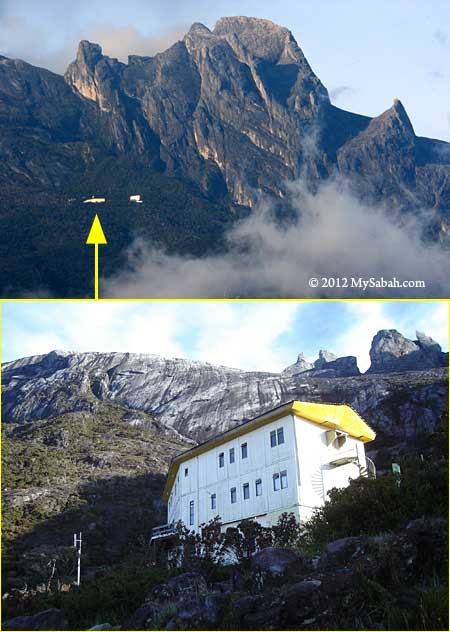
Pic: Hooray! Laban Rata! You are now 3,272 metres above sea level. This is the accommodation where most climbers spend a night.
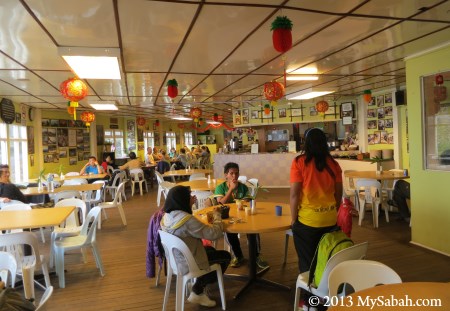
Pic: the restaurant of Laban Rata where you claim your buffet meals. You better reach Laban Rata before the restaurant closes at 7:30pm.
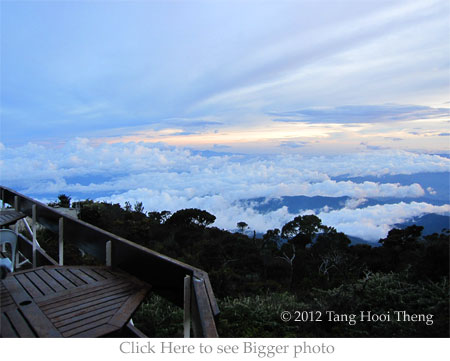
The scenery at Laban Rata is fantastic! Just enjoy the view with a cup of hot coffee in your hand. The dense cloud is under your feet. The sunset view at Laban Rata is one of the best in Sabah.
FYI, you can send postcard from the highest post box of Malaysia, which is located next to Pendant Hut in Laban Rata.
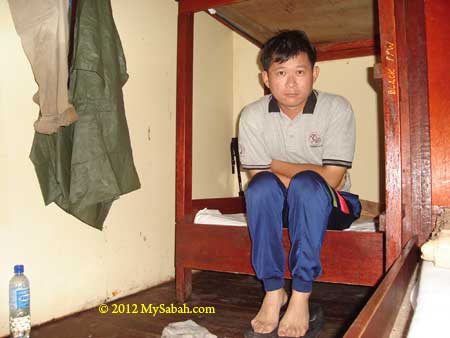
Pic: without heater, my room was freezing cold…
There are overnight accommodations provided for climbers on the mountain (Laban Rata Rest House, Gunting Lagadan Hut, Waras Hut and Lemaing Hostel). The rooms are humbly decorated but are comfortably equipped thick blankets, bunk beds, as well as clean drinking water.
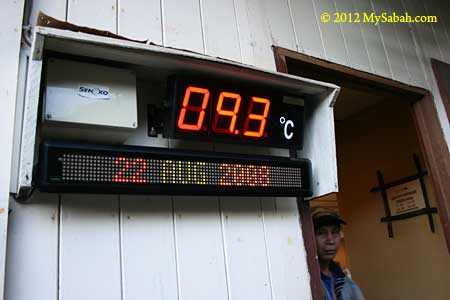
Pic: the temperature on the mountain can be lower than 10°C (50°F) and windy day makes it worse. It can be near freezing point near the summit so wear warm clothing.
Good Night! Sleep earlier because you need to wake up very early next day.
Day 2: Conquer Mt. Kinabalu
The climb to the summit resumes at 2am the next morning. The climb from Laban Rata to the summit normally takes 4 to 5 hours. To cut down weight, you leave unnecessary stuffs in Laban Rata. There is no water point to the summit (except Sayat-Sayat checkpoint). Carrying 1 Litre is quite enough as you won’t feel really thirsty under cold temperature.
The climb will start with steep ascend for about two hours on stairway. Then you will come to a section which is the most challenging part and requires you to hold onto a rope to move up. Just proceed slowly and cautiously.
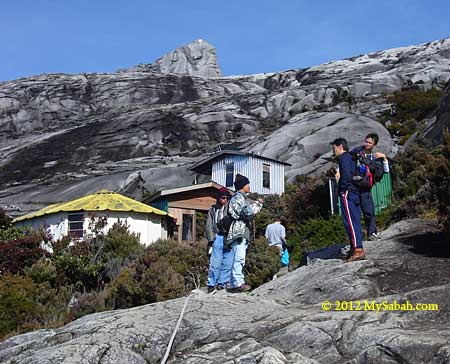
Pic: The Sayat-Sayat checkpoint. You need to register here so you can earn the certificate.
After Sayat-Sayat, the trail will be mainly flat rocky surface with 15 to 20 degrees of inclination.
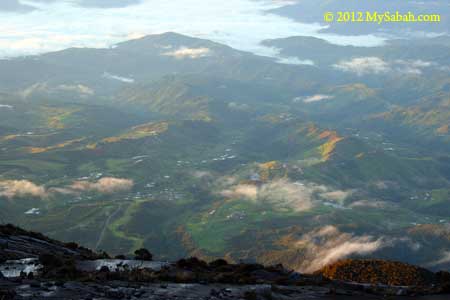
Pic: the nice view at 7th KM, where you can see Kota Belud town.
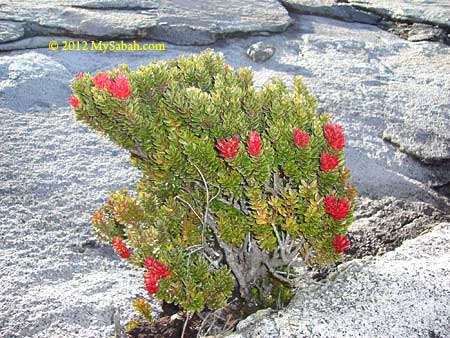
Pic: As you move upward to higher alpine zone, the vegetation will become thinner, so is the air. You will feel that your body is heavier and get tired easily.
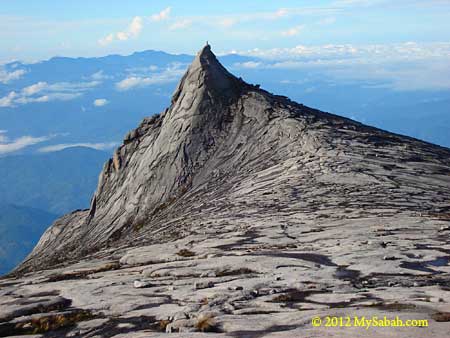
Pic: South Peak, the most photogenic peak of Mt. Kinabalu.
At this point, due to exhaustion, you would start to curse around and say “Why am I doing here?”. Be patient, my friend, you will be rewarded dearly later.
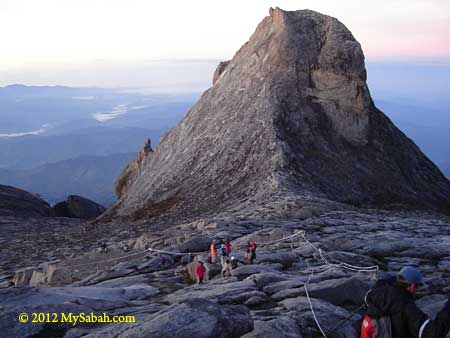
Pic: St John Peak, the 2nd highest peak (4090.7M). See the face in the peak?
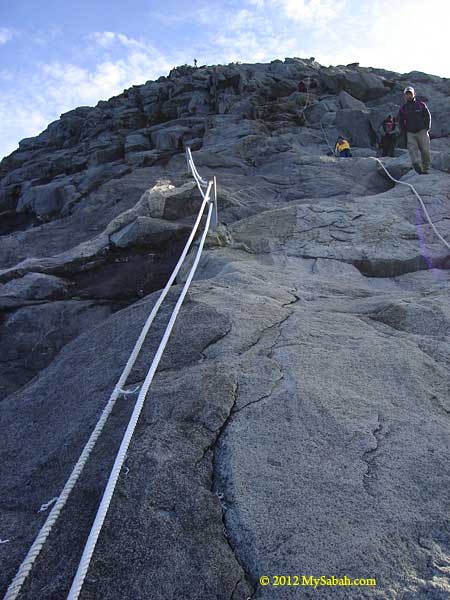
Pic: the last rope section to drain your last energy reserve. You have come this far so you must make it!
50,000 climbers leaves their footsteps here annually. Despite the hardship, none of them shows a face of regret on the summit. You have only an hour to enjoy the moment of your sweet victory, as the guide will ask you to leave before 8am, because the mountain will be covered in dense fog shortly (poor visibility).
Bonus: If you reach the summit before 6am, you will be rewarded by the beautiful sunrise view on the highest mountain of Borneo.
More Tips and Advices
- Pack Light. Don’t carry more than 6 Kg of weight for the climb. Those bringing huge backpacks can hire porters (for extra fee) to carry their bags for them.
- The climate is cool with an average temperature range of 15°C to 24°C (59°F to 75°F) at the Kinabalu Park Headquarters and 6°C to 10°C (42°F to 50°F) on the mountain. It can even go down to freezing point in coldest months (Nov-Dec). Climbers are recommended to wear breathable cotton clothing and comfortable pair of hiking boots.
- Climbers are also reminded to be ready with torch lights, raincoats and warm clothes in case it rains and the temperature drops.
- Descending stresses your knee and muscle more than ascending. Try to descend slowly to avoid serious joint and muscle pain later.
- Trail can be slippery after rain. Wear comfortable trekking or hiking shoes with good grip (best if it’s waterproof).
- Stay with your group and Mountain Guide at all times. Never walk off trail.
- Don’t climb if you have ailments such as asthma, hypertension, diabetes, heart disease and other sickness that severely affects your fitness.
- Always book the tour with licensed tour agent. There have been cases tourists cheated by unlicensed agents.
- Mt. Kinabalu is the Sacred Mountain (resting place of the deceased) of Sabah. Please be respectful and refrain from doing anything offensive to local belief such as taking nude photo.
- You may check out more photos of Mt. Kinabalu in my online album
Things to Bring
- Passport / MyKad (for registration)
- Proof of Accommodation Booking
- Drinking Water (in Refillable 1 Litre water bottle)
- LED Headlamp (head torch)
- Energy Bars / Chocolate Bars
- Light Backpack (best if come with raincover)
- Raincoat / Poncho (Murphy’s Law says it’ll rain if you don’t bring one)
- Toiletries (tissue paper, soap, toothbrush, toothpaste)
- Warm Clothing (Wind breaker, Fleece)
- Extra clothing and socks
- Glove
- Towel
- Cash
- Camera and spare Battery
- Medication such as painkiller, headache or altitude sickness tablet
- Plastic bags: to store rubbish and soil clothing
Condom- Optional: walking pole, sunblock lotion, sunglass, power bank
I hope you find this guide useful. Please feel free to add your tips in Comment section to perfect this guide for everyone.

Author: Nova Renata is a freelance writer and editor based in Kota Kinabalu, Sabah. When not writing at her desk, she will be cuddling her cat, clocking some miles or rolling on the mats. She aspires to be a best-selling author with solid six pack abs one day. Visit her Linked In profile.
Photos taken in Mt. Kinabalu, Sabah, Malaysia Borneo
For further information log on website :
http://www.mysabah.com/wordpress/how-to-climb-mount-kinabalu-and-how-much-it-cost/



















No comments:
Post a Comment